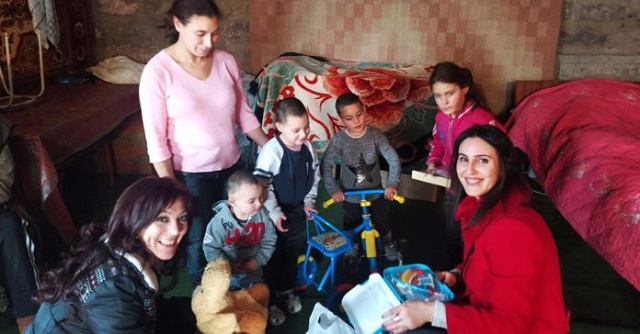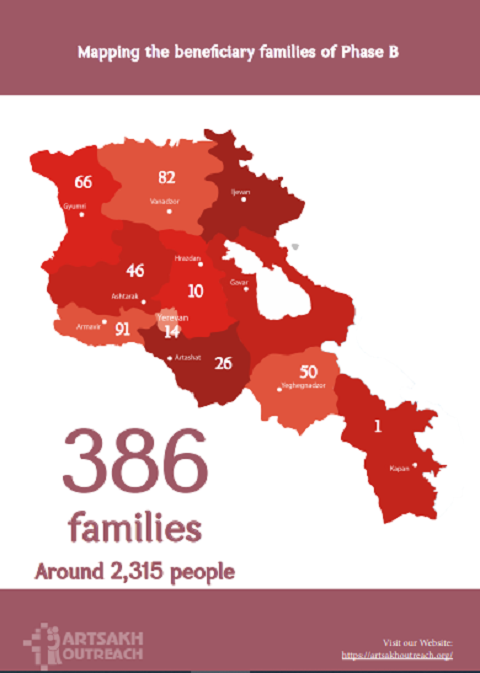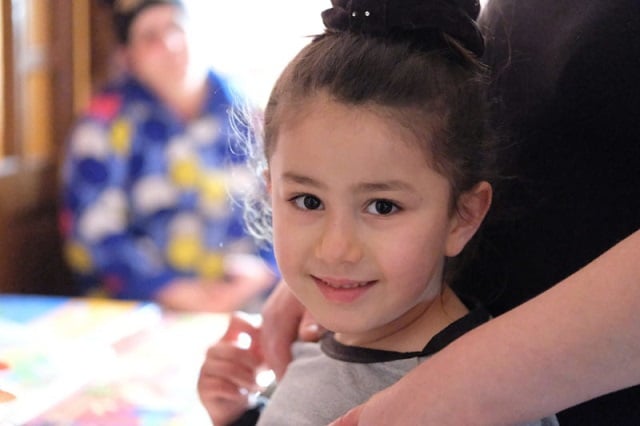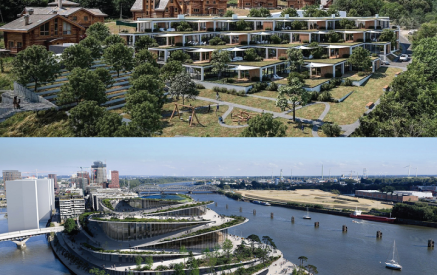ECHMIADZIN – The Artsakh war led to tens of thousands of Armenians fleeing to Armenia for refuge, while many others in Artsakh lost their homes, family members and livelihoods. There are many different humanitarian programs to help these people. One of the largest, Artsakh Outreach, was established last November by the Mother See of Echmiadzin under the direction of Catholicos of All Armenians Karekin II.
A committee of bishops and lay leaders from around the world, led by Archbishop Khajag Barsamian, Pontifical Legate of Western Europe and Representative of the Armenian Church to the Holy See (Vatican), was appointed to coordinate this effort, which is being carried out through Echmiadzin’s Social Services Department.
Read also
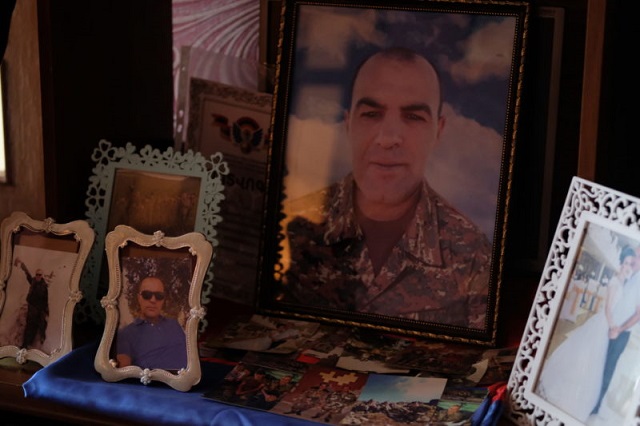
A shrine to the memory of Albert Bagiyants, who was killed during the war in Karvachar, kept by his family, temporarily staying in Vanadzor with support from Artsakh Outreach
Archbishop Barsamian said that his committee includes five high-ranking clergymen aside from himself from important centers of Armenian population in Armenia, Russia, Europe, Australia and the United States, as well as nine lay representatives, again from around the world. He exclaimed, “This is the obligation of the church — to reach out to those who are in need. This is a role that has been known throughout Armenian history from at least the times of St. Nerses the Great. Several decades ago, the Armenian Church responded immediately when the Armenian earthquake of 1988 took place.” He described how Archbishop Torkom Manoogian at that time rushed to Armenia with several Armenian-American philanthropists to see what assistance was necessary.
The Approach
The initial efforts, Archbishop Barsamian explained, were to provide the immediate needs of refugees in Armenia. Consequently, they were provided with food and hygienic requirements. Once a month each family was given a package to provide them with the supplies necessary for the month. This was done throughout Armenia by means of the local dioceses, and 205 families, or 1,100 people in all, were helped. Sponsors were found in the diaspora. Later, aid was extended to 181 more families for a total of 306 families, or 2,315 people.
In addition, during this first period, Catholicos Karekin noted the dire straits of around 17,500 children in Artsakh or refugees in Armenia, as well as children of families with wounded or dead soldiers. He suggested providing each with a package of gifts. With aid from the US, Canada, Moscow and elsewhere, some $200,000 was used to prepare in each diocese gifts including a bible, toys for the mind and stationery items, worth approximately $15 per package, to be given during the holidays.
The second stage of aid involves offering support to make sure families are able to remain in Armenia or Artsakh, by providing them necessities such as a home, a means to earn a living, and education. The feasibility of return to Artsakh is being evaluated, the archbishop said. For those whose homes are now under Azerbaijani control, a new program is being prepared so that they will not have to leave for Russia, the United States or Europe, but will be given the confidence that they can continue their lives in Armenia or other parts of Artsakh and not have to continue to rely on aid to do so.
Archbishop Barsamian stressed the importance of creating more development programs. Otherwise, he said that as in the aftermath of the Armenian earthquake, aid recipients will get used to idleness and relying on the assistance of others. He said, “This is not good. It is necessary to aid them so that they can act on their own and form their own future.”
A third stage will involve provision of psychological and spiritual assistance. Archbishop Barsamian spoke with Catholicos Karekin about a plan to deal with trauma. The losses Armenians experienced were not only of land and physical belongings. They also lost children, spouses, friends and family members. The number of wounded is great, while the fate of others, the “lost,” remains unknown. The trauma that resulted requires both psychological and spiritual healing. Archbishop Barsamian stated that the clergy must be trained in dealing with the situation.
To have the resources to accomplish these plans, all dioceses of the Church of Armenia outside of Armenia are asked to raise money, while the dioceses in Armenia, and Artsakh, will distribute the aid to refugees and execute the various projects. Archbishop Barsamian pointed out that the Mother See has a financial department, and a separate financial specialist will handle the accounting, so that these programs will not be a burden to it.
The Implementation
Fr. Markos Mangasaryan is the director of Echmiadzin’s Social Services Department. He said, “From the early days of the war, when our compatriots in Artsakh began to move to Armenia in the hundreds, then thousands, and then tens of thousands, the Mother See with all its wherewithal began to organize their reception in separate buildings, homes of believers, and communities. In Yeghegnadzor, Echmiadzin, Saghmosavan and Dzaghgadzor buildings were turned into dormitories for the displaced refugees.” Aid was also extended to families of the wounded, captive or dead.
Fr. Mangasaryan echoed the words of Archbishop Barsamian, as well as the intent of the catholicos, in stating that the Gospels provide a clear example of how to act, and so the church must give the refugees their material needs as much as possible.
He said that when refugees first started to come to Armenia, “all day and all night, my phone did not stop ringing.” All kinds of people, ranging from mayors to individual citizens called for help. Refugees came to the church in various ways. Sometimes they came on their own and other times individuals or organizations contacted the church. It was very disorderly, and the state, overwhelmed, had zero participation in the transportation process, Fr. Mangasaryan said. It only helped at the end of October when it became clear how bad the situation was, and sent buses to transport people from Artsakh. The state also did return people later to Artsakh with buses.
The aid effort at first was spontaneous, and work began even prior to the formation of the Artsakh Outreach committee. Fr. Mangasaryan said, “This was something that happened as if we were doing it for a thousand years. We have this tradition which we have inherited, especially during crisis periods. Somehow, it awakens and you do what is necessary even without coordination.”
After the establishment of the committee, it began to coordinate efforts and work to provide more financial means. With limited resources, Fr. Mangasaryan said that three criteria were used to determine which families should receive aid: 1. Those from the territories lost to Azerbaijan; 2. Families with a minimum of four children (non-adult); 3. Families without property (real estate) in Armenia.
In the Echmiadzin refugee shelter, Fr. Mangasaryan said that for the first month, he would speak practically every evening for hours about the worries of the displaced. He declared that many organizations would bring 40-50 people to a hotel or building and say, here is food and shelter for you, but then leave them on their own. It quickly became clear that this was insufficient. Fr. Mangasaryan said, “You cannot simply leave people who were displaced due to war and say go live…they must come out of their traumatic condition. They need contact with people who can listen to them.”
The Echmiadzin shelter hosted some 120 people over a period of four months. Some only stayed two weeks, others two months or even four months, but all know they must eventually leave, Mangasaryan said. The building has 20 rooms, but life is communal, with a cafeteria, and all expenses are paid for the residents. Those who leave find more appropriate housing in Armenia, return to Artsakh, or leave Armenia altogether.
The shelter in Yeghegnadzor helped some 300 people over the same four months. It probably received more refugees because it was closest to Artsakh, said Fr. Mangasaryan. Some refugees preferred to go to Lori (Gugark Diocese) because it was seen as the safest geographically.
He said that while the majority of the displaced, perhaps as many as 100,000 have by now returned to Artsakh, there are still over 25,000 refugees left in Armenia. Most of them are from the territories lost to Azerbaijan.
While the initial aid of food and hygienic supplies was given only in Armenia, he said that soon it will also be provided to those in Artsakh, as part of encouragement to refugees to return there, even if they lost their original homes to the Azerbaijanis. This is also what the Armenian and Artsakh governments desire.
Fr. Mangasaryan emphasized that the biggest problem in Artsakh was actually not food or water, but habitations. If the issue of housing is not quickly solved, it will lead to further emigration when the borders are opened, he said. The second big issue is employment.
He compared the situation with that of the Syrian-Armenian refugees in 2011-12. The latter came to Armenia but it was not possible to provide them with what they needed so they emigrated. The Syrian Armenians were in much better financial shape and enjoyed many advantages compared to the Artsakh refugees.
Many of the Artsakh refugees from lost areas like Hadrut or Berdzor actually were settled there decades ago from Armenia where they were in a poor socioeconomic condition. Now that they return to Armenia, having lost everything, they are in even worse shape than before. Fr. Mangasaryan estimates that at least half or more of the 25,000 left in Armenia at present fall into this category. Furthermore, covid-19 makes the present situation more difficult.
Nevertheless, the Artsakh Outreach committee has prepared plans to provide housing and work and after finalizing them will choose the preferred sites and the ways to provide the tools or the needed education and training for work. Fr. Mangasaryan accepts that these are huge tasks, but he declares, “We do not hesitate in doing this. No matter if we cannot help everyone, even if we help one person to not remain idle, this is important.”
The first priority, he said, is to keep these people in Armenia, and then eventually they can be transported to Artsakh when conditions permit.
Fr. Mangasaryan also confirmed that the Artsakh Outreach committee has a plan to work with families with psychological and spiritual difficulties. He observed that this is very apparent among soldiers who fought in the recent war, especially the young ones who were wounded. He said, “I do not know one soldier who participated in the war and returned who can sleep calmly now. I know many. I have visited their homes.” Children who have heard bombs or seen acts of violence also need healing. Aside from creating conditions for normal life and human contact, psychological and spiritual work is much needed, he said.
Who Is Doing the Work in Armenia?
In Echmiadzin, the Social Services Department has, in addition to its director, two deacons, one secretary, and two social workers who were brought on recently due to the Artsakh situation. It is primarily an administrative center which plans programs, Fr. Mangasaryan said.
Archbishop Barsamian said that a program manager and a public relations person will be added to its staff and people will also be hired for specific projects.
In addition to the Echmiadzin center, most dioceses in Armenia have their own social services departments. While these departments are formally subject to the direction of their diocese, each also coordinates its work with Fr. Mangasaryan. They each generally have a much larger staff than the Echmiadzin department since they directly deal with the population. Fr. Mangasaryan said that many have over ten staff members.
Finally, he remarked that every cleric in Armenia does the work of a social worker since he is aware of his community and what its needs are. The church tells the government, at various levels, about the information it has collected about who is from Artsakh in various regions, so that the same person does not get aid twice while another remains hungry. Fr. Mangasaryan observed that the government at present is not able to master this information or data on its own.
Aside from the Armenian government and the Armenia Fund, there are many other organizations doing humanitarian work, and Fr. Mangasaryan is in touch with them to be aware of what they are doing and to avoid duplication of efforts.
Finances
The total amount raised for aid as of February 3 is $667,000 according to the Artsakh Outreach Interim Report, but that figure, Fr. Mangasaryan said, does not include the aid given in kind in Armenia. Many in the church communities hosted Artsakh refugees, for a total of thousands, and sometimes did not give money but took care of their needs directly.
James Kalustian, a leader in the Diocese of the Armenian Church of America (Eastern) from the Boston area, is one of the lay members of the Artsakh Outreach committee who is involved with financial operations. He said that the process was a very transparent one, declaring, “We understand where the funds are going and who is getting supported.”
The general committee has formed a five-man financial subcommittee that meets weekly and authorizes all expenditures. He and Fr. Mangasaryan are among its members. Kalustian gave the example of a request for funds from a local Armenian diocese for families that needed help. After their number and needs were determined, a purchase order was made for the items that had to be purchased, and the subcommittee authorized the allocation of funds to the diocese. Each distribution has at least one clergyman present to witness the transfer, and efforts are being made to have a member of the local church youth group present too. Social workers will follow up on the situation, and in some cases writers and photographers are sent to document examples of distributions for publicity purposes.
An accountant, based in California, is a member of the financial subcommittee who keeps track of expenditures and every month checks the records, while in Armenia logging of funds continues. Kalustian said there will definitely be an annual financial report, but there may also be reporting twice a year or even quarterly.
A website, https://artsakhoutreach.org/, has been established to raise donations for the Artsakh Outreach effort and to publicize the work being carried out. The appeal for funds initially was just a general one, but now there is an attempt to quantify the amount needed to support families of various sizes for varying periods of time in order to make it easier for people to feel the impact their money is having, Kalustian said. Publicity for fundraising is primarily carried out through social media at present, he added.
While the initial thought was that the Artsakh Outreach work would be a three-to-six-months exercise, it is clear now, Kalustian said, that it will at least last a year, and perhaps even longer. Furthermore, it is possible that this effort will eventually turn into the equivalent of Catholic Charities for the Mother See of Echmiadzin, so that there will be a ready system to collect and distribute funds in the case of future disasters affecting Armenians, whether in Armenia or the diaspora. Kalustian gave the Beirut explosion last August as an example of an instance for which such a structure would have been useful.
During the Artsakh war of 2020, there was an unprecedented degree of support from the diaspora. Kalustian said, “With the end of the war, people have to realize that the needs are greater than ever. No one is going to help the Armenians besides the Armenians themselves right now. Hopefully aid will come from Russia, the European Union and the United States, but right now the responsibility is ours.”
For more information, readers can refer to the aforementioned Artsakh Outreach website or email Laura Gononian ([email protected]).
Main Photo Caption: Displaced children from Artsakh receiving presents




















































